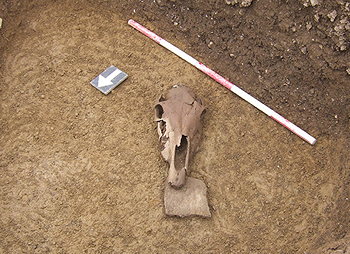Acoustic Skulls
When excavating medieval and early-modern buildings in northern Europe, archaeologists sometimes find horse skulls buried beneath them. One theory is that the skulls were placed there for magical, ritualistic reasons. Another possibility is that they served an acoustic purpose.
Sonja Hukantaival discusses this in her 2009 article "Horse Skulls and 'Alder-Horse': The Horse as a Building Deposit".
More info: IAC Archaeology

Sonja Hukantaival discusses this in her 2009 article "Horse Skulls and 'Alder-Horse': The Horse as a Building Deposit".
The practical, non-ritual, reason given for horse's skulls concealed in buildings is that they are placed under floors to create an echo. This has been suggested both in the British Isles and in Southern Scandinavia... Ceramic pots have also been concealed in buildings for acoustic reasons. The acoustic skulls were placed in churches, in houses and in Scandinavia especially in threshing barns.
In churches the acoustics were very important, of course. And in houses were people danced and music was played, but why in threshing barns? It was considered important that the sound of threshing carried far. Could this have some magic purpose? It is well known that in many cultures loud noises are considered to expel evil forces. So this "practical" custom of acoustic skulls may not be contradictory to magical and symbolic acts at all. One question to consider is also why horses' skulls were preferred. One would presume that the skulls of cattle would be available more often than those of horses, and possibly just as suitable for acoustics.
In churches the acoustics were very important, of course. And in houses were people danced and music was played, but why in threshing barns? It was considered important that the sound of threshing carried far. Could this have some magic purpose? It is well known that in many cultures loud noises are considered to expel evil forces. So this "practical" custom of acoustic skulls may not be contradictory to magical and symbolic acts at all. One question to consider is also why horses' skulls were preferred. One would presume that the skulls of cattle would be available more often than those of horses, and possibly just as suitable for acoustics.
More info: IAC Archaeology

Comments
Commenting is not available in this channel entry.



Category: Death | Medieval Era | Archaeology